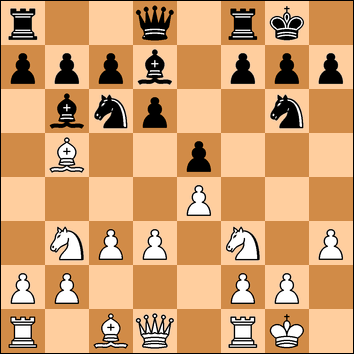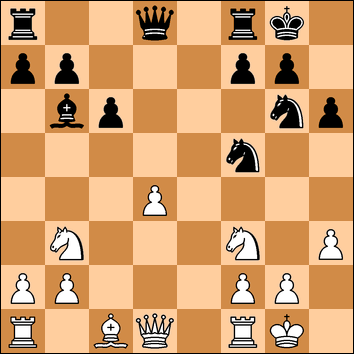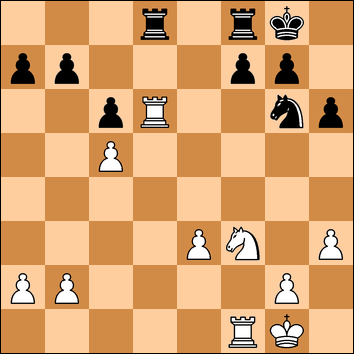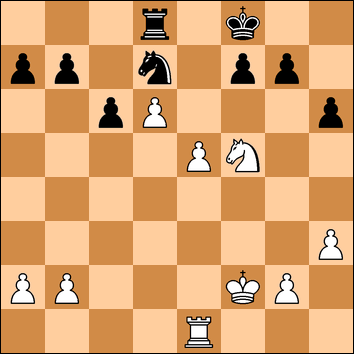Sunday 12 February 2017
White: K. Nevols (134) Black: D. Harvey (131)
Another long drive down to Hastings. It is a marvellous old club - I just wish it was a bit nearer home.
1. e4 e5
2. Nf3 Nc6
3. Bb5 Bc5
The Ruy Lopez Classical Defence - the oldest defence - quite fitting for our location. White could play 4. c3 or even, if he fancies it, 4. Nxe5!? but castling looks straight forward.
4. O-O Nge7
Now 4. .. Nd4 or 4. ..Nf6 are more usual. This looked like a solid enough defence but White really can now play 5. Nxe5 Nxe5 6. d4 and get some initiative. (Apparently White has won 65% of games in this line).
Not one for such early risks, I decided to stick to the normal Ruy Lopez build-up.
5. c3 O-O
I now gave a lot of thought to 6. d4 - then 6. ... exd4 7. cxd4 Bb6. This position of the bishop and the slight weakness of the d-pawn made me slightly nervous, although White is better after 8. d5 Nb8 9. Nc3.
In the end I decided for calm development and protect the e-pawn.
6. d3 d6
Black has the same thought. There are further opportunities to play d4 before I finally do so.
7. h3 Bd7
8. Nbd2 Ng6
8. .. a6 would be good for Black with either 9. Bxc6 Nxc6 or 9. Ba4 b5 10. Bb3 and then either 10. .. Na5 or 10. .. Bb6.
9. Nb3 Bb6

At last the d4 move arrives, but I gave some consideration to 10. a4 with either 10. .. a6 11. Bc4 Na5 12. Nxa5 Bxa5 13. b4 or 10. .. a5. The computer recommends 10. Bg5 developing with tempo with 10. .. f6 11. Bc4+ Kh8 12. Be3 or 10. .. Qe8 11. Be3 - aiming to open up the f-file and also strengthen a d4 push.
10. d4 exd4
11. cxd4 Nce7
12. Bc4 c6
Black could have taken over the initiative with 12. .. a5! 13. a4 Qe8 but he plans to block the Bishop on c4 and swap a few pieces off to ease any central pressure. I take a time out to cause a slight weakness.
13. Ng5 h6
14. Nf3 d5
15. Bd3 dxe4
16. Bxe4 Bf5
17. Bxf5 Nxf5

The computer rates this position as dead level. Indeed it does look very boring.
18. Be3 Qd6
I now see a sequence to take over the d-file but overlook a tactic - and fortunately he does so too. Playing 19. Qd3 simply keeps things even.
19. Nc5? Bxc5?
But 19. .. Nxe3! wins a pawn. 20. fxe3 Bxc5 21. dxc5 Qxc5. Not only is Black a pawn ahead but White has a weak isolated pawn on e3. If then 22. Qb3 Black has 22. .. Rad8! with advantage.
20. dxc5 Qxd1
21. Raxd1 Nxe3
This was the drawback to my plan - I get an isolated e-pawn anyway - but I least I saw that bit.
22. fxe3 Rad8
23. Rd6

And now we are at the position that I had foreseen at move 19. The plan is to double up the rooks, or get an advance passed pawn, and play Kf2, with hopefully e4-e5.
At this stage, all the clocks were stopped so that everyone could have a tea break in the kitchen. This was a new one - games being stopped in the middle. I had heard once of a power cut in a tournament hall, and everyone had to stop their clocks and were told to stop thinking, but a planned stoppage I had not come across before.
It was difficult to drink a glass of water and eat a chocolate mini-roll while playing over the position in my head. My opponent must have had the same thought as we both returned to the board early to resume our game before the others.
23. .... Ne7
Planning to block on the d5 square - another reason why the creation of a new e-pawn is very useful.
24. Rfd1 Rxd6
25. cxd6 Nd5
Now I rejected the immediate 26. e4 Nf6 27. e5 Nd5 as I wanted to offer some king support, but this would have been a better move.
26. Kf2?! Rd8
Black could have considered 26. .. f5 which stops the e-pawn advance but also opens up some squares for the White knight. The position would still be equal.
27. e4 Nf6
28. e5
Advancing with 28. Ke3 is slightly better.
28. ... Nd5
29. Nd4 Kf8
30. Nf5 Nb6
31. Re1 Nd7

White could now consider 32. a3 with b4 to follow to add some pressure on the queenside, although it does not make sense to me to cause weaknesses on the side where my pawns are in a minority. So I decide to force the issue.
32. e6 fxe6
33. Rxe6 Nc5
I gave some thought here to 34. Re7?? which, I discovered afterwards, loses a pawn to 34. .. Rxd6. But I continue in trying to get something from the position.
34. Re2 Rd7
35. Ke3 Rf7
36. Ng3 Rf6
37. Rd2 Re6+
38. Kf4 Ke8
39. b4 Rf6+
Black had thought White could not play 40. Kg4 because of 40. .. Rg6+ 41. Kh4 Rxg3 although 42. Re2+ would sidestep that tactic. I did not see that - but could not see any future for the king on that side of the board. Considering Black will round up the d6 pawn eventually, and that I had no winning chances at all I agreed to the draw.
40. Ke3 Re6+
41. Kf4 Rf6+
42. Ke3
Draw
Hastings v Swale
Robert Elliston (181) 0-1 Keith Hyde (167)
Marc Bryant (141) 0-1 Trefor Owens (172)
Derek Harvey (131) 1/2-1/2 Keith Nevols (134)
Adrian Cload (127) 0-1 Peter Blundell (120)
Jeremy Hudson (125) 1/2-1/2 Tyrone Jefferies (116)
Omer Namouk (122) 1/2-1/2 Andrew Gillard (113)
Hastings 1.5-4.5 Swale
No comments:
Post a Comment